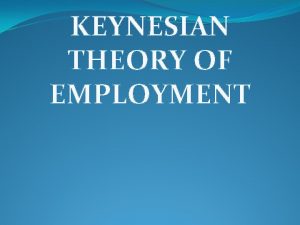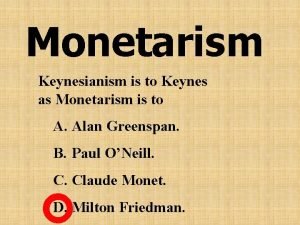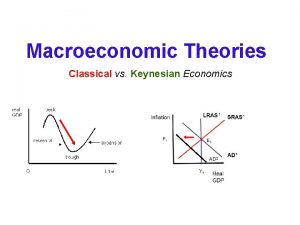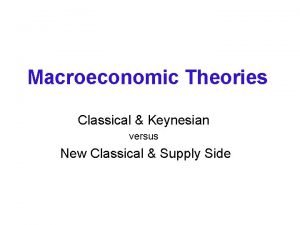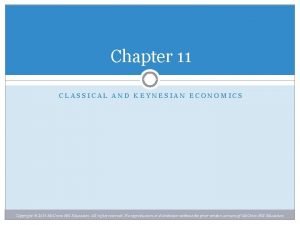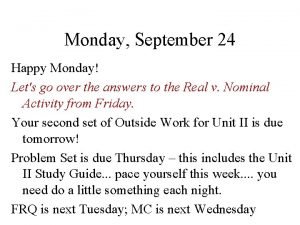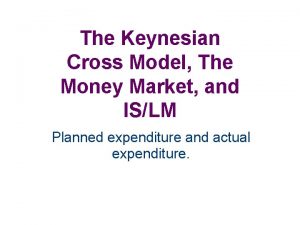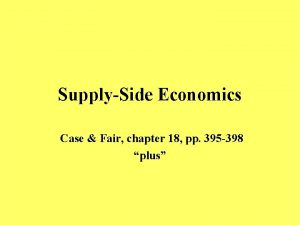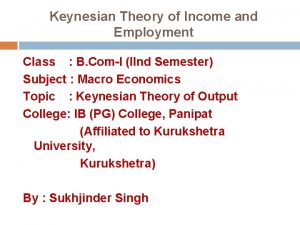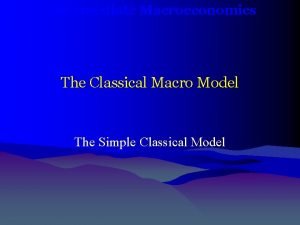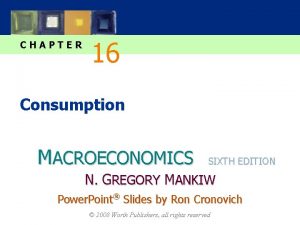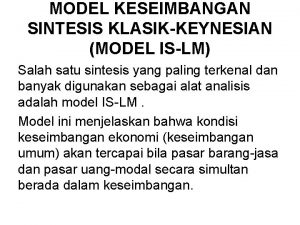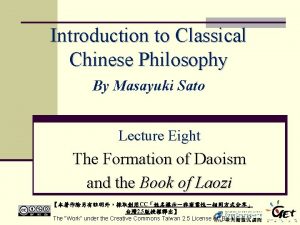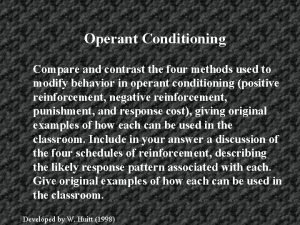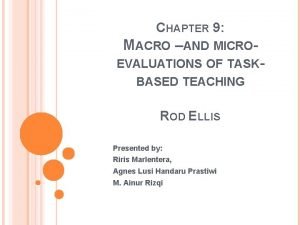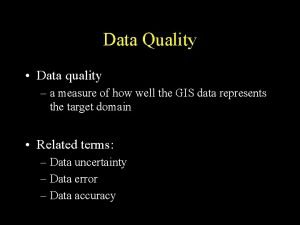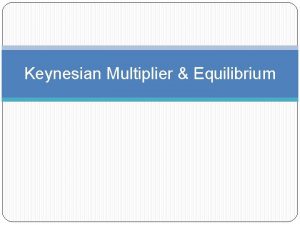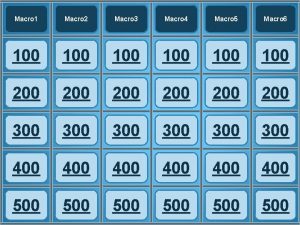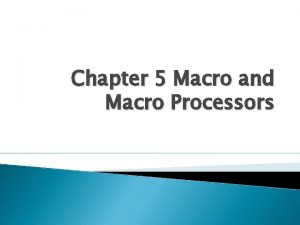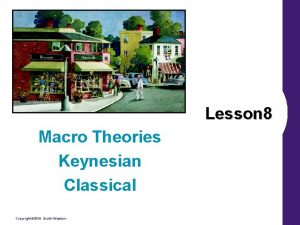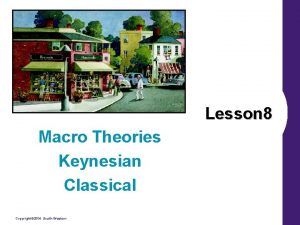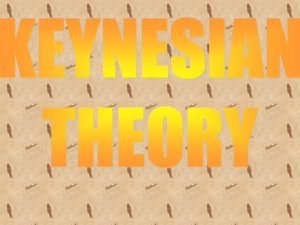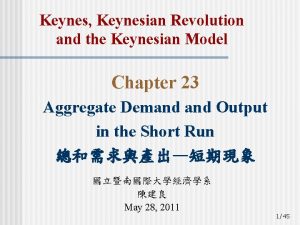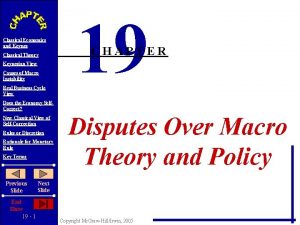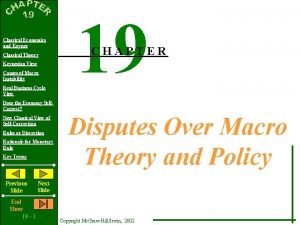Chapter 11 Classical and Keynesian Macro Analyses Introduction

















































- Slides: 49

Chapter 11 Classical and Keynesian Macro Analyses

Introduction Among the many factors influencing the rate of GDP growth is the volume of business regulation. Concerns about terrorism have multiplied the amount of documentation that must accompany cargo arriving in U. S. ports. How does this affect real GDP? 2

Learning Objectives n Discuss the central assumptions of the classical model n Describe the short-run determination of equilibrium GDP and the price level in the classical model n Explain the circumstances under which the short-run aggregate supply curve may be either horizontal or upward-sloping 3

Learning Objectives n Understand what factors cause shifts in the short-run and long-run aggregate supply curves n Evaluate the effects of aggregate demand supply shocks on equilibrium real output in the short run n Determine the causes of short-run variations in the inflation rate 4

Chapter Outline n The Classical Model n Equilibrium in the Labor Market n Keynesian Economics and the Keynesian Short-Run Aggregate Supply Curve n Output Determination Using Aggregate Demand Aggregate Supply 5

Chapter Outline n Determinants of Aggregate Supply n Effects of a Weaker Dollar 6

Did You Know That. . . n Different approaches to economic analysis have different views of price flexibility? n The Keynesian approach emphasizes the idea that prices of final goods and services may be slow to respond to higher input prices? 7

The Classical Model n The classical model was the first attempt to explain fluctuations in: – – – – Inflation Output Income Employment Consumption Saving Investment 8

The Classical Model n Assumptions of the classical model – Pure competition exists – Wages and prices are flexible – People are motivated by self-interest – People cannot be fooled by money illusion 9

The Classical Model n Consequences of the assumptions – Minimize the role of government in the economy – If all prices and wages are flexible, any problems in the macroeconomy will be temporary – The power of the market will keep the economy at full-employment in the long run 10

The Classical Model n Say’s Law – Supply creates its own demand. – Producing goods and services generates the means and the willingness to purchase other goods and services. 11

Equating Desired Saving and Investment in the Classical Model Desired Saving Interest Rate (percent) 14 12 10 8 Desired Investment 6 4 2 0 Figure 11 -2 600 700 800 900 Investment and Saving per Year ($ billions) 12

Equating Desired Saving and Investment in the Classical Model n Summary – Changes in saving and investment create a surplus or shortage in the short run. – In the long run, this is offset by changes in the interest rate. – This interest rate adjustment returns the market to equilibrium where S = I. 13

The Classical Model n Question – Would unemployment be a problem in the classical model? n Answer – No, classical economists assumed that the wage would always adjust to the full employment level. 14

Example: Will Low Rates of Personal Saving Choke Off Investment Spending? n Personal saving rates have fallen dramatically in the U. S. over the past decade. n But rates of gross private domestic investment are steady. n Firms have been able to access sources of financing other than personal saving, such as their own retained earnings and funds invested by foreigners. 15

The Classical Model of the Labor Market Figure 11 -3 16

The Classical Model of the Labor Market Table 11 -1 17

Classical Theory and Vertical Aggregate Supply n In the classical model, long-term unemployment is impossible n The long-term aggregate supply curve is the only one the matters. n Rapid adjustment of prices and wages will move the economy to an equilibrium position on the long-run curve. 18

Classical Theory and Increases in Aggregate Demand LRAS Price Level n Observations – Increase in AD creates disequilibrium 120 • Quantity AD (Y 1) > Quantity AS (Y 0) A 1 E 1 AD 2 AD 1 Y 0 Figure 11 -4 Y 1 Real GDP per Year 19

Classical Theory and Increases in Aggregate Demand LRAS Price Level n Observations 130 120 – Price level increases returning the economy to equilibrium E 2 • P = 120, Real GDP = Y 0 A 1 – Only the price level changes E 1 AD 2 AD 1 Y 0 Figure 11 -4 – Real GDP supply determined Y 1 Real GDP per Year 20

Effect of a Decrease in Aggregate Demand in the Classical Model Figure 11 -5 21

Keynesian Economics and the Keynesian Short-Run Aggregate Supply Curve n Some assumptions – Prices are not flexible – Short-run approach 22

Price Level Demand-Determined Output Equilibrium SRAS P 0 AD 1 Y 1 Figure 11 -6 Real GDP per Year 23

Price Level Demand-Determined Output Equilibrium With excess capacity, increases in AD increase equilibrium real national income, and the price level does not change. SRAS P 0 AD 1 Y 1 Figure 11 -6 AD 2 Y 2 Real GDP per Year 24

Price Level Demand-Determined Output Equilibrium SRAS P 0 AD 3 Y 3 Figure 11 -6 Y 1 AD 2 Y 2 Real GDP per Year 25

Real GDP and the Price Level, 1934– 1940 Figure 11 -7 26

The Keynesian Short-Run Aggregate Supply Curve n The Keynesian model – Sources of price rigidities • Union contracts • Long-term contracts for raw materials, etc. – AD determines equilibrium real GDP – Capitalism may not be self-regulating 27

The Keynesian Short-Run Aggregate Supply Curve n The impact of a change in AD differs depending on the shape of the SRAS. n In the Keynesian model, the SRAS curve has one portion that is flat, and another portion that is upward-sloping. 28

Income Determination with Fixed versus Flexible Prices Price Level LRAS SRAS 120 AD 1 0 Figure 11 -8 12 Real GDP per Year ($ trillions) SRAS AD 1 0 12. 0 Real GDP per Year ($ trillions) 29

Income Determination with Fixed versus Flexible Prices Price Level LRAS SRAS 120 SRAS 130 120 AD 2 AD 1 0 Figure 11 -8 12 13 Real GDP per Year ($ trillions) AD 1 0 12. 5 Real GDP per Year ($ trillions) 30

Income Determination Using Aggregate Demand Aggregate Supply: Fixed versus Changing Price Levels n The Keynesian model n The classical model – Rigid prices – Flexible prices – Short-run view – Long-run view – AD determines output – LRAS determines output 31

Shifts in Both Short- and Long-Run Aggregate Supply Figure 11 -9 32

Shifts in SRAS Only Figure 11 -10 33

Determinants of Aggregate Supply n Changes that cause an increase in aggregate supply: – Discoveries of new raw materials – Increased competition – A reduction in international trade barriers – Fewer regulatory impediments to business – An increase in labor supplied – Increased training and education – A decrease in marginal tax rates – A reduction in input prices 34

Determinants of Aggregate Supply n Changes that cause a decrease in aggregate supply: – – – – Depletion of raw materials Decreased competition An increase in international trade barriers More regulatory impediments to business A decrease in labor supplied Decreased training and education An increase in marginal tax rates An increase in input prices 35

Consequences of Changes in Aggregate Supply and Demand n Aggregate Demand Shock – Any shock that causes the aggregate demand curve to shift inward or outward n Aggregate Supply Shock – Any shock that causes the aggregate supply curve to shift inward or outward 36

The Short-Run Effects of Stable Aggregate Supply and a Decrease in Aggregate Demand: The Recessionary Gap Figure 11 -11 37

The Short-Run Effects of Stable Aggregate Supply and an Increase in Aggregate Demand: The Inflationary Gap Figure 11 -12 38

The Effects of Stable Aggregate Demand a Decrease in Aggregate Supply: Cost-Push Inflation Figure 11 -14 39

International Example: Korea Experiences Cost-Push Inflation n Winds and flooding from Typhoon Maemi in September 2003 caused significant damage to Korea’s infrastructure and productive capacity. n We depict this as a leftward shift of short-run aggregate supply, with a corresponding temporary decline in real GDP. 40

International Example: Korea Experiences Cost-Push Inflation Figure 11 -15 41

The Effects of a Weaker Dollar n Decrease in the value of the dollar raises the cost of imported inputs. n SRAS decreases n With AD constant, the price level rises n GDP decreases Figure 11 -16, Panel (a) 42

The Effects of a Weaker Dollar n Decrease in the value of the dollar makes net exports rise. n AD increases n With SRAS constant, the price level rises along with GDP Figure 11 -16, Panel (b) 43

Issues and Applications: An Aggregate Supply Shock in Cargo n Measures contained within the 2002 Trade Act require transportation companies to give prior notice to U. S. government officials of shipments arriving internationally. n The costs of complying with this regulation have caused an aggregate supply shock. 44

Summary Discussion of Learning Objectives n The four assumptions of the classical model are: – Pure competition – Completely flexible wages and prices – People are motivated by self-interest – No money illusion 45

Summary Discussion of Learning Objectives n Both the short-run and long-run aggregate supply curves are vertical at the full employment level of output. n If output prices and wages and input prices are “sticky, ” the short-run aggregate supply curve can be horizontal. 46

Summary Discussion of Learning Objectives n Both the long-run and short-run aggregate supply curves will shift due to changes in resource endowments and technology. Changes in resource prices cause the SRAS curve to shift. n Aggregate demand supply shocks change the equilibrium level of real output in the short-run. 47

Summary Discussion of Learning Objectives n Causes of short-run variations in the inflation rate: – An increase in aggregate demand – A decrease in short-run aggregate supply 48

End of Chapter 11 Classical and Keynesian Macro Analyses
 Explain the keynesian theory of employment
Explain the keynesian theory of employment New classical and new keynesian macroeconomics
New classical and new keynesian macroeconomics Monetarist vs keynesian vs classical
Monetarist vs keynesian vs classical New classical and new keynesian macroeconomics
New classical and new keynesian macroeconomics Monetarism vs keynesianism
Monetarism vs keynesianism Keynesian vs classical
Keynesian vs classical Classical economics vs keynesian
Classical economics vs keynesian Keynesian vs classical vs monetarist
Keynesian vs classical vs monetarist Keynesian policy
Keynesian policy Classical economics vs keynesian
Classical economics vs keynesian Keynesian vs classical vs monetarist
Keynesian vs classical vs monetarist Classical versus keynesian economics
Classical versus keynesian economics Examples of critical thinking in nursing practice
Examples of critical thinking in nursing practice Happy
Happy Single pass macro processor
Single pass macro processor Concln
Concln Wwh set
Wwh set Courtage analyses services
Courtage analyses services Keynesian cross
Keynesian cross Keynesian cross
Keynesian cross Keynesian vs supply side
Keynesian vs supply side Explain the keynesian theory of employment
Explain the keynesian theory of employment Keynesian consumption function
Keynesian consumption function Keynesian consumption function
Keynesian consumption function Keynesian model
Keynesian model Keynesian model
Keynesian model Austrian economics vs keynesian
Austrian economics vs keynesian Model keseimbangan keynesian
Model keseimbangan keynesian Mohist mechanism
Mohist mechanism The fourth course in the french classical menu is
The fourth course in the french classical menu is Examples of buffet froid
Examples of buffet froid Introduction to classical chinese philosophy
Introduction to classical chinese philosophy Introduction to classical chinese philosophy
Introduction to classical chinese philosophy Chapter 5 ancient greece
Chapter 5 ancient greece Fixed interval schedule example
Fixed interval schedule example Relationship between the micro market and macro environment
Relationship between the micro market and macro environment Powerpoint drag and drop macro
Powerpoint drag and drop macro Disadvantages of microteaching
Disadvantages of microteaching Micro teaching format
Micro teaching format Characteristics of micro enterprises
Characteristics of micro enterprises Define micro and macro ethics
Define micro and macro ethics Muscle cell structure
Muscle cell structure Macro evaluation
Macro evaluation Micro and macro environment
Micro and macro environment Venn diagram macroeconomics vs. microeconomics
Venn diagram macroeconomics vs. microeconomics Data quality in gis
Data quality in gis Micro and macro world
Micro and macro world Micro and macro economics venn diagram
Micro and macro economics venn diagram Advanced macro facilities in system software
Advanced macro facilities in system software Micro and macro circulation
Micro and macro circulation
